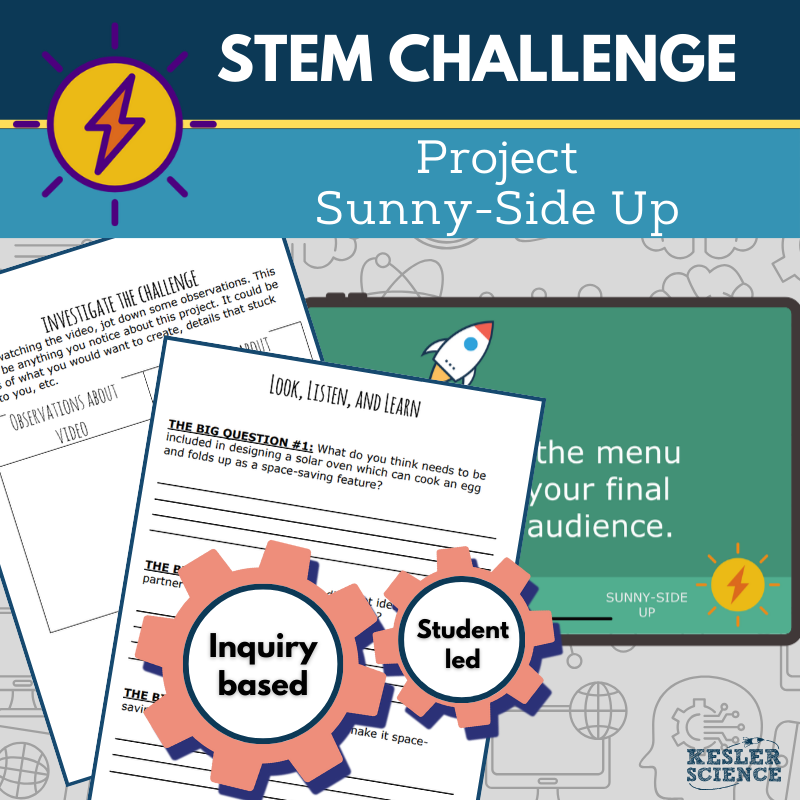
STEM Challenge - Project Sunnyside Up - Build a Solar Oven
Looking for a flexible, multi-day activity that gets your students “doing science?” Every STEM Challenge offers a hands-on, inquiry-based, student-led project designed to allow them to step into the roles of researchers and engineers.
STEM Challenge projects are ideal for use at any time throughout the school year, between units, before breaks, or during afternoons when testing weeks occur.
For teachers, there are presentations and step-by-step guides to facilitate pacing and lesson plans that align with standards. Students utilize the included notebooks to guide them through activities (both individually and in small groups), challenge them to learn new information, and reflect on and apply the information they have learned.
The Challenge:
After a recent catastrophic event, millions of people are without power and won't be getting it anytime soon. Your classmates have teamed up to create inexpensive solar ovens to be delivered to the disaster victims. Your goal is to learn all about the different types of solar ovens and build one that can reach a temperature to safely cook an egg. Shipping hundreds of ovens across the country can get expensive. An efficient solution will include the ability for the oven to fold up to save space during shipment. Your thoughtfulness and empathy towards this cause should be commended. Good luck on your project.
What’s in a STEM Challenge?
- a video explaining the engineering challenge and setting the context for the project
- a BIG Question to guide the inquiry
- teacher presentation in PPT (Google-compatible) and Keynote
- a teacher's guide on what the teacher and students should be doing along the way
- student notebook offers
- questions to provide the students with a framework for their inquiry throughout the entire project
- opportunities to absorb new information and reflect on ways to use it to complete the challenge
- Using the LAUNCH process, students brainstorm with their peers and reflect on failures and opportunities, with the prospect of sharing their ideas with the world. This holds students accountable, and they will put forth the best effort, knowing that other students could critique the project.
- Each STEM Challenge contains a list of suggested supplies for its project. We were very cautious about choosing inexpensive items, and the supply list is dynamic, allowing for adjustments to individual situations. Suggested supplies include:
- Cardboard or cardboard box
- Box knife or scissors (Use with Care)
- Aluminum foil
- Clear tape
- Plastic wrap (a heavy-duty or freezer zip lock bag will also work)
- Black construction paper
- Newspapers
- Ruler or wooden spoon
- Thermometer
- Glue
- Scissors
- Paper
- Tape
- Insulation (optional)
- Oven mitt
- Dish or pan
- Egg (or just determine the temperature an egg would cook)
Supports Next Generation Science Standards:
MS-PS3-3
Apply scientific principles to design, construct, and test a device that either minimizes or maximizes thermal energy transfer.
MS-ETS1-1
Define the criteria and constraints of a design problem with sufficient precision to ensure a successful solution, taking into account relevant scientific principles and potential impacts on people and the natural environment that may limit possible solutions.
MS-ETS1-2
Evaluate competing design solutions using a systematic process to determine how well they meet the criteria and constraints of the problem.
MS-ETS1-3
Analyze data from tests to determine similarities and differences among several design solutions to identify the best characteristics of each that can be combined into a new solution to better meet the criteria for success.
MS-ETS1-4
Develop a model to generate data for iterative testing and modification of a proposed object, tool, or process such that an optimal design can be achieved.
Pickup currently not available
Terms of Use
Copyright © Kesler Science, LLC. All rights reserved by the author. This product is to be used by the original downloader only. Copying for more than one teacher, classroom, department, school, or school system is prohibited. Permission is never granted to enter Kesler Science materials into any form of AI for any purpose. This product may not be distributed or displayed digitally for public view. Failure to comply is
copyright infringement and a violation of the Digital Millennium Copyright Act (DMCA). Clipart and elements found in this PDF are
copyrighted and cannot be extracted and used outside of this file without permission or license. Intended for classroom and personal use ONLY. Multiple licenses are available for purchase by departments,
schools, or school districts. Contact support@keslerscience.com for more information.









